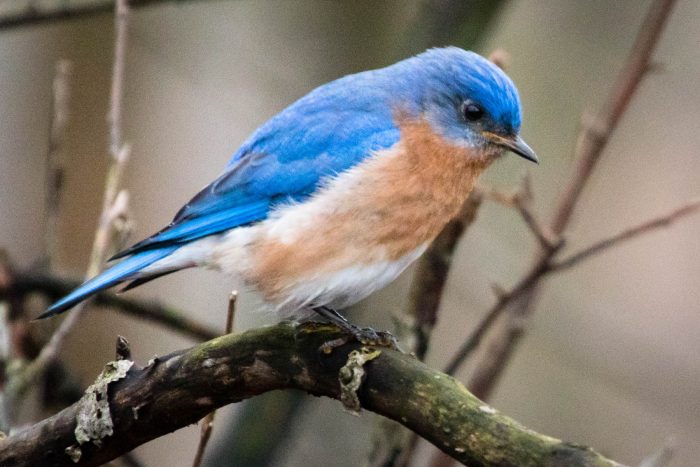Eastern Bluebird
Sialia sialis
The eastern bluebird is a small, plump bird in the thrush family. It can be found throughout the Chesapeake Bay region.
This section shows one large critter image at a time. Use the thumbnails that follow to select a specific image to display here.

This gallery contains a grid of small thumbnails. Selecting a thumbnail will change the main image in the preceding section.
Appearance
Eastern bluebirds are small birds in the thrush family. They have plump bodies, and large round heads with short, straight beaks. They have long wings and a wingspan of around 10 to 13 inches, but their tails and legs are short. Adult males have deep blue backs, rusty or brick-red coloring on their throat and breast, and bright white bellies. Adult females are more gray-blue, with duller orange-brown breast coloring.
Feeding
Eastern bluebirds prefer to eat ground-dwelling insects, such as caterpillars, beetles, crickets, grasshoppers and spiders. They’ll perch on wires, posts, and low branches in open country, or in nest boxes and old woodpecker holes, and scour the landscape for prey. They can spot prey from over 60 feet away, and feed by diving down from above to grab their prey. In the colder months, eastern bluebirds perch on late-fruiting trees to eat berries, including:
- Mistletoe
- sumac
- Blueberries
- Black cherry
- Tupelo
- Currants
- Wild holly
- Dogwood berries
- Hackberries
- Honeysuckle bay
- Pokeweed
- Juniper berries.
Predators
Adult and baby eastern bluebirds are hunted by snakes, cats, black bears, raccoons and other birds like house sparrows, and their eggs are eaten by eastern chipmunks and flying squirrels. Additionally, male eastern bluebirds will fiercely defend their nesting boxes and tree cavities, often attacking any other species they deem a threat, including house sparrows, European starlings, tree swallows, great crested flycatchers, Carolina chickadees, brown-headed nuthatches, robins, bluejays, mockingbirds and cowbirds.
Flight
The flight pattern of eastern bluebirds is low to the ground and fast, with an irregular pattern to their wingbeats. When competing for territory or nesting locations, males can chase each other at high speed and tussle. Their fights include beak clacking, feet grappling, feather pulling and wing hitting.
Voice
The call of the eastern bluebird is soft and low-pitched, made to keep in touch with each other or to signal that adults are on their way back to the nest with food. The tu-a-wee sound lasts about a second, with males’ calls typically slightly longer than females’. Eastern bluebirds also have a low-pitched, warbling song made up of several phrases of one to three short notes, lasting about two seconds. Males will sing this song to attract a mate, and females sing it when they see predators on their territory.
Reproduction and life cycle
Reproduction begins with the adult male eastern bluebird carrying bits of nesting material in and out of the nest. The male will spread his wings and tail to sing and flutter in front of the female. They will sometimes preen each others’ feathers and feed each other, all to entice her to enter the nest hole with him. This nest hole is made of weeds, twigs and dry grass, lined with finer grass and sometimes animal hair or feathers. Nest holes can be found in the cavity of a hollow tree, in an old woodpecker hole or in a birdhouse.
Bluebirds mate for several seasons. The female lays between three and seven pale blue eggs. She incubates her eggs for 13 to 16 days, until they hatch. For the next three weeks, both parents and young from the previous brood bring food to the nestlings, until they leave the nest at about 18 to 19 days on average. Eastern bluebirds produce two to three broods each year.
Did you know?
- The eastern bluebird is the state bird of New York and Missouri.
- Farmers love eastern bluebirds because they eat the insects that damage crops.
- Adult males will sometimes sing soft songs while females lay their eggs.
Sources and additional information
- All About Birds: Eastern Bluebird Identification - Cornell Lab of Ornithology
- Eastern Bluebird - Audubon Guide to North American Birds
